Hp COMPAQ PROLIANT 5000, COMPAQ PROSIGNIA 500, COMPAQ PROLIANT 4500, COMPAQ PROLIANT 4000, COMPAQ PROSIGNIA 720 Backup of Windows NT SAP R/3 Systems with ARCserve
...
WHITE PAPER
December 1996 |
|
Compaq Computer |
|
Corporation |
|
CONTENTS |
|
Test Environment .......... |
3 |
Test Concept ................ |
4 |
ARCserve |
|
Functionality ................. |
5 |
ARCserve Installation............ |
5 |
ARCserve Manager ............... |
6 |
ARCserve Tape Label |
|
Handling ............................ |
10 |
ARCserve Engine |
|
Administrator ...................... |
12 |
ARCserve RAID |
|
Engine ........................ |
13 |
Tape Array Functionality....... |
13 |
Compression Tests ....... |
15 |
Capacity of DLT Cartridges... |
15 |
Compression Factor of an |
|
Initial R/3 System ................ |
15 |
Compression Factor of a |
|
Productive R/3 System ......... |
16 |
Summary ............................ |
16 |
Performance of the |
|
Disk Subsystem ........... |
17 |
ARCserve Backup ......... |
21 |
Backup on Windows NT File |
|
System Level ...................... |
21 |
Backup Using the Image |
|
Option ................................ |
22 |
Online Backup Using ARCserve |
|
R/3 Agent for Oracle ............ |
24 |
Online Backup Using R/3 |
|
SAPDBA ............................. |
28 |
Network Backups .......... |
29 |
Pull Agent ........................... |
30 |
Push Agent ......................... |
32 |
ARCserve Restore ........ |
32 |
Restore of Windows NT File |
|
Backup ............................... |
32 |
Restore of Image Backup...... |
34 |
Restore of Online R/3 |
|
Database Agent Backup ....... |
35 |
Restore of an SAPDBA |
|
Backup ............................... |
36 |
Summary ..................... |
38 |
Appendix ..................... |
39 |
.
.
.
.
.
.
.
.
.
.
.
.
.
.
.
.
.
.
.
.
.
.
.
.
.
.
.
.
.
.
.
.
.
.
.
.
.
.
.
.
.
.
.
.
.
.
.
.
.
.
.
.
.
.
.
.
.
.
.
.
.
.
.
.
.
.
.
.
.
.
.
.
.
.
.
.
.
.
.
.
.
.
.
.
.
.
.
.
.
.
.
.
.
.
.
.
.
.
.
.
.
.
.
.
.
.
.
.
.
.
.
.
.
.
.
.
.
.
.
.
.
.
.
.
.
.
.
.
.
.
.
.
.
.
.
.
.
.
.
.
.
.
.
.
.
.
.
.
.
.
.
.
.
.
.
.
.
Backup of Windows NT SAP R/3 Systems with ARCserve
EXECUTIVE SUMMARY
Cheyenne is the main partner of Compaq for backup solutions. According to the growing interest on professional backup solutions Compaq did an evaluation of the functionality and performance of Cheyenne ARCserve 6 for Windows NT, which is documented in this White Paper.
Compaq tested the functionality of ARCserve 6 but the main focus of the tests was to get performance data of backup and restore in various corner scenarios that will allow predictions for real-life behavior. All the tests were done with SAP R/3 on an Oracle system.
The maximum backup rate that was achieved for a backup on Windows NT file system level was 39 GB/h. Using the ARCserve Image Option that bypasses the Windows NT file system for even higher performance between 46 GB/h and 53 GB/h could be stored, depending on the type of tape RAID array. Compaq also did online R/3 backups, simulating different load conditions by using the SAP benchmark suite. The backup rate was between 20 GB/h with high R/3 load and 43 GB/h with low R/3 load.
The restore rate was not primarily determined by the tape drive subsystem, but in the high performance cases was restricted to the write performance of the disk subsystem. The maximum restore rate was between 19 GB/h and 25 GB/h depending on the type of the disk RAID array.
466A/1196 |
1 |

WHITE PAPER (cont.)
.
.
.
.
.
.
.
.
.
.
.
.
.
.
.
.
.
.
.
.
.
.
.
.
.
.
.
.
.
.
.
.
.
.
.
.
.
.
.
.
.
.
.
.
.
.
.
.
.
.
.
.
.
.
.
.
.
.
.
.
.
.
.
.
.
.
.
.
.
.
.
.
.
.
.
.
.
.
.
.
.
.
.
.
.
.
.
.
.
.
.
.
.
.
.
.
.
.
.
.
.
.
.
.
.
.
.
.
.
.
.
.
.
.
.
.
.
.
.
.
.
.
.
.
.
.
.
.
.
.
.
.
.
.
.
.
.
.
.
.
.
.
.
.
.
.
.
.
.
.
.
.
.
.
.
.
.
NOTICE
The information in this publication is subject to change without notice.
CO M P A Q CO M P U T E R CO R P O R A T I O N S H A L L N O T B E L I A B L E F O R T E C H N I C A L O R E D I T O R I A L E R R O R S O R O M I S S I O N S C O N T A I N E D H E R E I N, N O R F O R
I N C I D E N T A L O R C O N S E Q U E N T I A L D A M A G E S R E S U L T I N G F R O M T H E F U R N I S H I N G, P E R F O R M A N C E, O R U S E O F T H I S M A T E R I A L.
This publication does not constitute an endorsement of the product or products that were tested. The configuration or configurations tested or described may or may not be the only available solution. This test is not a determination of product quality or correctness, nor does it ensure compliance with any federal, state or local requirements. Compaq does not warrant products other than its own strictly as stated in Compaq product warranties.
Product names mentioned herein may be trademarks and/or registered trademarks of their respective companies.
Compaq, Contura, Deskpro, Fastart, Compaq Insight Manager, LTE,PageMarq, Systempro, Systempro/LT, ProLiant,TwinTray, ROMPaq, LicensePaq, QVision, SLT, ProLinea, SmartStart, NetFlex, DirectPlus, QuickFind, RemotePaq, BackPaq, TechPaq, SpeedPaq, QuickBack,PaqFax, Presario, SilentCool, CompaqCare (design),Aero, SmartStation, MiniStation, and PaqRap, registered United States Patent and Trademark Office.
Netelligent, Armada, Cruiser, Concerto,QuickChoice,ProSignia, Systempro/XL, Net1, LTE Elite, Vocalyst,PageMate, SoftPaq, FirstPaq, SolutionPaq,EasyPoint, EZ Help,MaxLight, MultiLock, QuickBlank, QuickLock,UltraView, Innovate logo, Wonder Tools logo in black/white and color, and Compaq PC Card Solution logo are trademarks and/or service marks of Compaq Computer Corporation.
Other product names mentioned herein may be trademarks and/or registered trademarks of their respective companies.
©1996 Compaq Computer Corporation. All rights reserved. Printed in theU.S.A.
Microsoft, Windows, Windows NT, Windows NT Advanced Server, SQL Server for Windows NT are trademarks and/or registered trademarks of Microsoft Corporation.
Backup of Windows NT SAP R/3 Systems with ARCserve
First Edition (December 1996) 466A/1196
466A/1196 |
2 |

WHITE PAPER (cont.)
.
.
.
.
.
.
.
.
.
.
.
.
.
.
.
.
.
.
.
.
.
.
.
.
.
.
.
.
.
.
.
.
.
.
.
.
.
.
.
.
.
.
.
.
.
.
.
.
.
.
.
.
.
.
.
.
.
.
.
.
.
.
.
.
.
.
.
.
.
.
.
.
.
.
.
.
.
.
.
.
.
.
.
.
.
.
.
.
.
.
.
.
.
.
.
.
.
.
.
.
.
.
.
.
.
.
.
.
.
.
.
.
.
.
.
.
.
.
.
.
.
.
.
.
.
.
.
.
.
.
.
.
.
.
.
.
.
.
.
.
.
.
.
.
.
.
.
.
.
.
.
.
.
.
.
.
.
TEST ENVIRONMENT
The following lists show what hardware and software was used in the test environment.
Hardware
The following hardware was used for evaluating the Cheyenne ARCserve product:
Computer |
Compaq ProLiant 5000 |
Processors |
2 x 200 MHz Pentium Pro, L2 Cache 512 Kbytes |
Memory |
1 gigabyte |
Disks |
C: 2 x 2.1 gigabyte RAID1 |
|
E: 2 x 2.1 gigabyte RAID1 |
|
F: 10 x 4.3 gigabyte RAID 5 |
|
G: 2 x 2.1 gigabyte |
Controller |
4 x Compaq 32 bit Fast Wide SCSI-2 Controller for Compaq 15/30 |
|
DLT Tape Drives |
|
2 x Compaq SMART-2 Array Controller for Disks |
Tapes |
8 x Compaq 15/30 DLT Tape Firmware 840B |
Network |
100 Mbit Ethernet |
Software
The following software was used for evaluating the Cheyenne ARCserve product:
Operating system |
Windows NT3.51, Build 1057, SSD 1.18, Service Pack 4 |
Database |
Oracle 7.2.2.4.5 |
Database Data |
SAP IDES Client Version 3.0D |
SAP R/3 |
R/3 3.0D |
SAP R/3 backup tools |
SAPDBA 3.0C |
Oracle Agent |
Cheyenne R/3 Agent for Oracle 2.0 |
Backint Agent |
Cheyenne R/3 Agent for Oracle 2.0 |
Backup product |
Cheyenne ARCserve 6.0 |
DLT driver |
Cheyenne ARCserve DLT driver |
466A/1196 |
3 |

WHITE PAPER (cont.)
.
.
.
.
.
.
.
.
.
.
.
.
.
.
.
.
.
.
.
.
.
.
.
.
.
.
.
.
.
.
.
.
.
.
.
.
.
.
.
.
.
.
.
.
.
.
.
.
.
.
.
.
.
.
.
.
.
.
.
.
.
.
.
.
.
.
.
.
.
.
.
.
.
.
.
.
.
.
.
.
.
.
.
.
.
.
.
.
.
.
.
.
.
.
.
.
.
.
.
.
.
.
.
.
.
.
.
.
.
.
.
.
.
.
.
.
.
.
.
.
.
.
.
.
.
.
.
.
.
.
.
.
.
.
.
.
.
.
.
.
.
.
.
.
.
.
.
.
.
.
.
.
.
.
.
.
.
TEST CONCEPT
The test scenarios discussed in this White Paper focused on the parallel operation of DLT tape devices to improve backup performance. Compaq testing verified the functionality of the integration solution and then investigated different off-line and online scenarios.
NOTE: Compaq does not recommend using DAT tape drives for production systems due to their low performance and reliability. All tests for this White Paper were run only with DLT tape drives.
Testing revealed that the particular configuration of a disk subsystem has much more influence on the performance than initially expected. As you read this White Paper, then, you will find some test scenarios using different disk subsystem configurations to show how the configurations effected performance.
Test scenarios, although carefully chosen, create certain results which might not always be achievable in all production sites. In addition, these tests are not meant to substitute or complement any of the vendor’s quality tests of these software products.
To have representative data Compaq used the SAP IDES client. Together with the SAP R/3 benchmark client the database had a size of about 16gigabytes. See the Appendix for detailed information.
The tests in this document are divided into the following parts:
∙ Functionality of ARCserve
Testing the functionality of the ARCserve software.
∙ Compression tests
The goal of these tests was to well understand hardand software compression and to determine typical compression figures for R/3 on Oracle systems.
∙ Performance of the disk subsystem
These tests determine the performance characteristics of the disk drive array.
∙ Backup tests
Testing on Backup of files, Image backup, Online backup with ARCserve R/3 Agent for Oracle, Off-line and online backup with theSAPDBA via backint. See section “ARCserve Functionality” for detailed information about the different backup types.
∙ Restore tests
Testing on Restore of files, Image restore, Restore with ARCserve R/3 Agent for Oracle, Restore with theSAPDBA via backint.
466A/1196 |
4 |
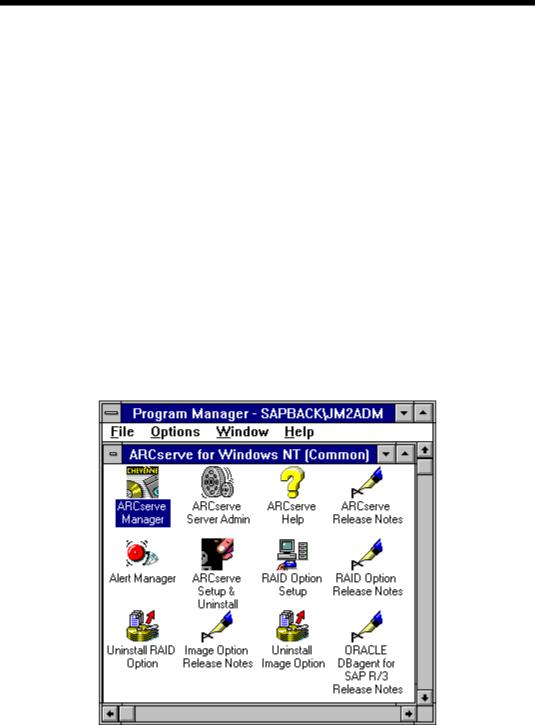
WHITE PAPER (cont.)
.
.
.
.
.
.
.
.
.
.
.
.
.
.
.
.
.
.
.
.
.
.
.
.
.
.
.
.
.
.
.
.
.
.
.
.
.
.
.
.
.
.
.
.
.
.
.
.
.
.
.
.
.
.
.
.
.
.
.
.
.
.
.
.
.
.
.
.
.
.
.
.
.
.
.
.
.
.
.
.
.
.
.
.
.
.
.
.
.
.
.
.
.
.
.
.
.
.
.
.
.
.
.
.
.
.
.
.
.
.
.
.
.
.
.
.
.
.
.
.
.
.
.
.
.
.
.
.
.
.
.
.
.
.
.
.
.
.
.
.
.
.
.
.
.
.
.
.
.
.
.
.
.
.
.
.
.
ARCSERVE FUNCTIONALITY
The following section briefly describe the functionality of ARCserve. See the Cheyenne ARCserve documentation for more detailed information.
ARCserve Installation
ARCserve is installed by simply calling the setup program on the ARCserve CD. The basic ARCserve component is installed first.The following options have to be purchased and installed separately:
∙SAP R/3 agent for backup and restore of an Oracle based R/3 system. This agent includes the backint interface for an R/3 backup using the SAPDBA program. The SAP R/3 agent is similar to the Oracle database agent but additionally contains some special settings for R/3.
∙Image option forfastest backup and restore of completepartitions, bypassing the Windows NT file system.
∙RAID engine foroperating severalphysical tape drives ina drive array, which is very similar to the RAID operation of hard disks in a disk drive array.
After you have installed the core product plus all available options of ARCserve you get a program group in your Windows NT Program Manager as shown in Figure 1.
Figure 1: ARCserve program group
If you are using thebackint interface you additionally have to:
∙edit the init<SID>.sap parameter file that contains the settings for the R/3 backup and restore :
backup_dev_type =util_file
util_par_file = <name of the ARCserve parameter file, e.g. initJM2.utl>
466A/1196 |
5 |

WHITE PAPER (cont.)
.
.
.
.
.
.
.
.
.
.
.
.
.
.
.
.
.
.
.
.
.
.
.
.
.
.
.
.
.
.
.
.
.
.
.
.
.
.
.
.
.
.
.
.
.
.
.
.
.
.
.
.
.
.
.
.
.
.
.
.
.
.
.
.
.
.
.
.
.
.
.
.
.
.
.
.
.
.
.
.
.
.
.
.
.
.
.
.
.
.
.
.
.
.
.
.
.
.
.
.
.
.
.
.
.
.
.
.
.
.
.
.
.
.
.
.
.
.
.
.
.
.
.
.
.
.
.
.
.
.
.
.
.
.
.
.
.
.
.
.
.
.
.
.
.
.
.
.
.
.
.
.
.
.
.
.
.
∙edit the ARCserve parameter file forbackint (e.g. initJM2.utl) by defining the tapes that should be used for the backup (see Appendix for an example file)
Both files can be found in the %ORACLE_HOME%\database directory.
The following section will give you some brief information of the functionality of ARCserve 6.0 for Windows NT. See the ARCserve documentation or a product information of ARCserve for further information.
ARCserve Manager
The ARCserve Manager is the main program that is used for nearly all operations.
After the startup of the ARCserve Manager you get the Quick Access window as shown in Figure 2 where you can decide which operation you want to start. You can chose between:
∙Job Status
∙Backup
∙Restore
∙Copy
∙Media Pool Management
∙Device Management
∙Database
∙Reports
Figure 2: Quick Access window
You can switch to any other options after you started at any time.
466A/1196 |
6 |
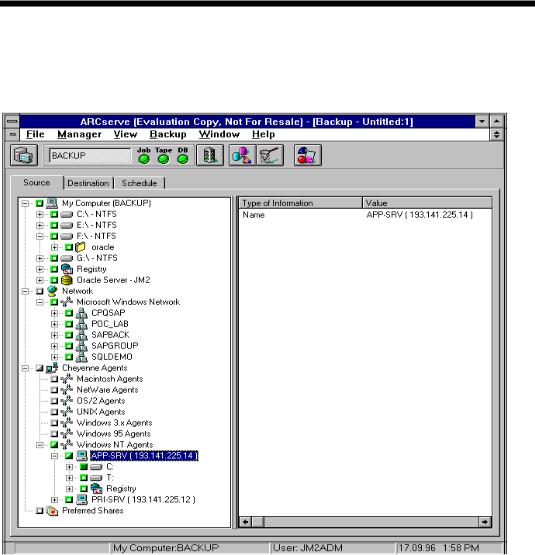
WHITE PAPER (cont.)
.
.
.
.
.
.
.
.
.
.
.
.
.
.
.
.
.
.
.
.
.
.
.
.
.
.
.
.
.
.
.
.
.
.
.
.
.
.
.
.
.
.
.
.
.
.
.
.
.
.
.
.
.
.
.
.
.
.
.
.
.
.
.
.
.
.
.
.
.
.
.
.
.
.
.
.
.
.
.
.
.
.
.
.
.
.
.
.
.
.
.
.
.
.
.
.
.
.
.
.
.
.
.
.
.
.
.
.
.
.
.
.
.
.
.
.
.
.
.
.
.
.
.
.
.
.
.
.
.
.
.
.
.
.
.
.
.
.
.
.
.
.
.
.
.
.
.
.
.
.
.
.
.
.
.
.
.
Backup
If you choose the backup item, the Backup window is displayed as shown in Figure 3. At this point, you can select which kind of backup you want to start or schedule.
Figure 3: Backup window
There are three major groups of backup that are provided by ARCserve for Windows NT.
The first groupis the local backup (My Computer) where you can select single files, complete disks, the registry, or databases if you have installed any database agent. If you select a complete disk and you have installed the add-on Image Option you can make an image backup of this disk. ARCserve Image Option for Windows NT allows the backup/restore of local hard drives in the image mode. Image Option bypasses the Windows NT file system. Image Option reads/writes data at sector level and also uses asynchronous I/O mechanisms for highest performance.
The R/3 database agent allows you to backup the complete database in online mode including the SAPARCH directory and control files.
ARCserve provides the option to backup the registry of a running Windows NT.
The second groupis the network backup (Network) that allows you to backup files via an Windows NT share(pull concept). There is also an option to backup the registry of remote servers.
The third groupis the agent backups (Cheyenne Agents) that allows you to backup data from Macintosh, Netware, OS/2, UNIX, Windows 3.x, Windows 95, and Windows NTclients (push
466A/1196 |
7 |
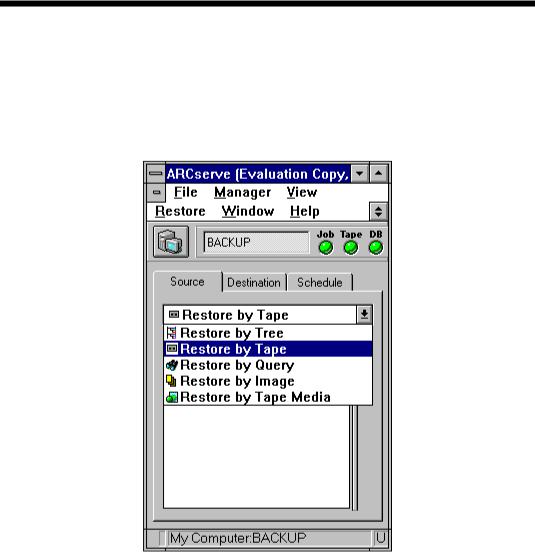
WHITE PAPER (cont.)
.
.
.
.
.
.
.
.
.
.
.
.
.
.
.
.
.
.
.
.
.
.
.
.
.
.
.
.
.
.
.
.
.
.
.
.
.
.
.
.
.
.
.
.
.
.
.
.
.
.
.
.
.
.
.
.
.
.
.
.
.
.
.
.
.
.
.
.
.
.
.
.
.
.
.
.
.
.
.
.
.
.
.
.
.
.
.
.
.
.
.
.
.
.
.
.
.
.
.
.
.
.
.
.
.
.
.
.
.
.
.
.
.
.
.
.
.
.
.
.
.
.
.
.
.
.
.
.
.
.
.
.
.
.
.
.
.
.
.
.
.
.
.
.
.
.
.
.
.
.
.
.
.
.
.
.
.
concept). For this kind of backup you have to install the agent software on the clientand configure the new connection on the server.
Restore
If you choose the restore item, the Restore window is displayed as shown in Figure 4. At this point, you can choose which kind of restore you want to start.
Figure 4: Restore window
Each restore job requires a source and a destination.The files selected as your source will always come from a tape.The location selected as your destination will always be a hard drive.
ARCserve provides you with four methods for selecting the data you want to restore (the source) which are:
∙Restore by Tree
∙Restore by Tape
∙Restore by Query
∙Restore by Tape Media
The first three methods use information logged inARCserve’s database, while the fourth method does not. In addition, if you have purchased separately the Image Backup Option, Restore by Image will also be available. You also have several methods for selecting a destination to restore the data to the machine.
466A/1196 |
8 |
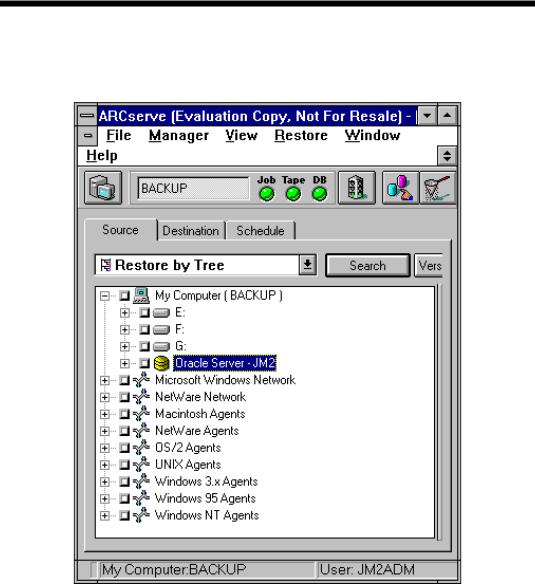
WHITE PAPER (cont.)
.
.
.
.
.
.
.
.
.
.
.
.
.
.
.
.
.
.
.
.
.
.
.
.
.
.
.
.
.
.
.
.
.
.
.
.
.
.
.
.
.
.
.
.
.
.
.
.
.
.
.
.
.
.
.
.
.
.
.
.
.
.
.
.
.
.
.
.
.
.
.
.
.
.
.
.
.
.
.
.
.
.
.
.
.
.
.
.
.
.
.
.
.
.
.
.
.
.
.
.
.
.
.
.
.
.
.
.
.
.
.
.
.
.
.
.
.
.
.
.
.
.
.
.
.
.
.
.
.
.
.
.
.
.
.
.
.
.
.
.
.
.
.
.
.
.
.
.
.
.
.
.
.
.
.
.
.
The Restore by Treeview allows you restore a specific directory or drive. This view displays a machine tree of files and directories that were backed up with ARCserve as shown in Figure 5. It is also possible to restore individual files from an Image Backup.
Figure 5: Restore by Tree
First of all the Restore by Tapeallows you to select the tape, then the session, and finally, the files and directories you want to restore. This source view is useful if you know the tape that holds the data you want to restore, but you are not sure of the right session it is in.
466A/1196 |
9 |
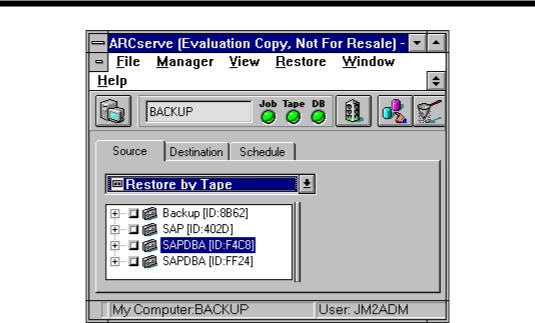
WHITE PAPER (cont.)
.
.
.
.
.
.
.
.
.
.
.
.
.
.
.
.
.
.
.
.
.
.
.
.
.
.
.
.
.
.
.
.
.
.
.
.
.
.
.
.
.
.
.
.
.
.
.
.
.
.
.
.
.
.
.
.
.
.
.
.
.
.
.
.
.
.
.
.
.
.
.
.
.
.
.
.
.
.
.
.
.
.
.
.
.
.
.
.
.
.
.
.
.
.
.
.
.
.
.
.
.
.
.
.
.
.
.
.
.
.
.
.
.
.
.
.
.
.
.
.
.
.
.
.
.
.
.
.
.
.
.
.
.
.
.
.
.
.
.
.
.
.
.
.
.
.
.
.
.
.
.
.
.
.
.
.
.
Figure 6: Restore by Tape
The Restore by Querysource is used to restore files when you already know the name of the file or directory you want to restore, but you do not know the machine it was backed up from or the tape(s) it was backed up to. This view also uses the ARCserve database. As long as the file and directory information is logged in the database, you can effectively use this view to select files to restore.
The Restore by Tape Mediaallows you to restore complete sessions on a tapeto a tape device. All files in this session are restored to the destination, unless filters are added to the job. This
source is either useful in case information from your ARCserve database is unavailable, or in case you try to recover your network after a disaster.
Image mode restore ("Restore by Image" mode in ARCserve Restore Manager) overwrites the target volume data.
ARCserve Tape Label Handling
The ARCserve tape label handling is done by the different tools. The first one is theDevice Manager.
If you have more than one tape device connected to your Windows NT machine, ARCserve lets you separate them into two or more "groups". Establishing tape groups is a key component of ARCserve's flexibility and efficiency.
The tape groups enable you to perform the following options:
∙parallel streaming - you can have several operations occurring simultaneously, one at each tape group configured for your system.
∙automated tape spanning - if, during a backup session, the tape becomes filled, ARCserve automatically spans to another tape in another device within the same tape group.
By default, ARCserve is installed with each tape device assigned to its own group. ARCserve finds identical tape drives during the installation, placing them automatically in the same group. Later, you can use the Device Manager to regroup your devices. As you can have up to seven tape devices connected to each SCSI bus in your machine, you can have up to seven tape groups per SCSI board.
466A/1196 |
10 |

WHITE PAPER (cont.)
.
.
.
.
.
.
.
.
.
.
.
.
.
.
.
.
.
.
.
.
.
.
.
.
.
.
.
.
.
.
.
.
.
.
.
.
.
.
.
.
.
.
.
.
.
.
.
.
.
.
.
.
.
.
.
.
.
.
.
.
.
.
.
.
.
.
.
.
.
.
.
.
.
.
.
.
.
.
.
.
.
.
.
.
.
.
.
.
.
.
.
.
.
.
.
.
.
.
.
.
.
.
.
.
.
.
.
.
.
.
.
.
.
.
.
.
.
.
.
.
.
.
.
.
.
.
.
.
.
.
.
.
.
.
.
.
.
.
.
.
.
.
.
.
.
.
.
.
.
.
.
.
.
.
.
.
.
There is only one rule when assigning tape devices to the same group; the devices in the group must be identical. That means they must be the same make and model.
The Device Manager is also used for formatting tapes. By formatting a tape you can specify a tape name, which represents together with the tape ID (4 digits chosen by ARCserve) a kind of tape label.
Figure 7: Format window
The second tool is theMedia Pool Managementutility.
A media pool is a collection of media managed as a unit. Tape rotation or grandfather-father-son (GFS) methods of backup are based on media pools. Each media pool is assigned a name and the media is organized according to serial numbers. The serial numbers assigned are permanent and if you are using a device with a bar code reader, the bar code labels will be used for the serial number of the media. The media pools are organized by the range of serial numbers of the media they contain and are divided into two sets, the Save Set and the Scratch Set.
The set of media containing important data that can not be overwritten is called the Save Set. Once the media has passed several criteria these will be recycled and re-used. The media from the Save Set, that has met several criteria (minimum number of media to save and retention period) and therefore can be re-used and overwritten, is placed in the Scratch Set.
Each time a media is written to, it moves from the Scratch Set to the Save Set. That media will move back to the Scratch Set once the specified criteria have been met.
Media pools apply to every media, regardless of the selected backup type and method. All rotation backup jobs will create their own media pool based on the name entered in the Media Pool Name field of the Schedule dialog box for simple rotation, or the prefix entered in the Media Pool Name Prefix field with GFS enabled. The GFS backup uses three media pools:
∙Daily
∙Weekly
∙Monthly
These three pools are also based on the information entered in the Media Pool Name Prefix field. For example, if you enter ACTG as the Media Pool Name Prefix for an GFS backup job, the Daily media pool name would be ACTG_DLY.
For a simple (single media pool) rotation, you specify the complete name for the media pool.
466A/1196 |
11 |
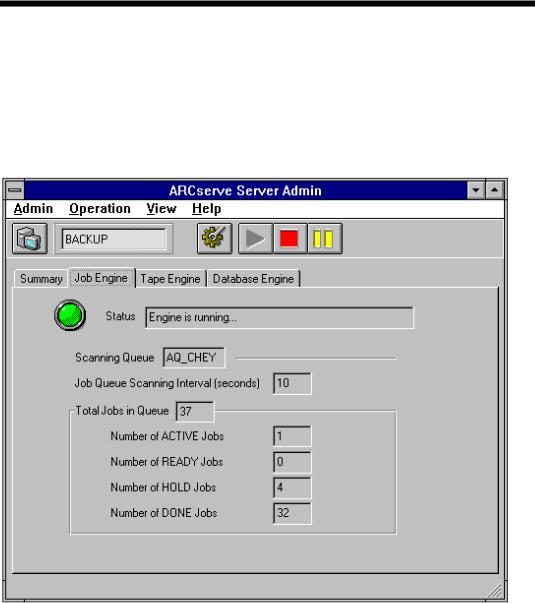
WHITE PAPER (cont.)
.
.
.
.
.
.
.
.
.
.
.
.
.
.
.
.
.
.
.
.
.
.
.
.
.
.
.
.
.
.
.
.
.
.
.
.
.
.
.
.
.
.
.
.
.
.
.
.
.
.
.
.
.
.
.
.
.
.
.
.
.
.
.
.
.
.
.
.
.
.
.
.
.
.
.
.
.
.
.
.
.
.
.
.
.
.
.
.
.
.
.
.
.
.
.
.
.
.
.
.
.
.
.
.
.
.
.
.
.
.
.
.
.
.
.
.
.
.
.
.
.
.
.
.
.
.
.
.
.
.
.
.
.
.
.
.
.
.
.
.
.
.
.
.
.
.
.
.
.
.
.
.
.
.
.
.
.
ARCserve Engine Administrator
In the ARCserve Windows NT group, you can find the ARCserve Engine Administrator. With the Engine Administrator you are able to start and stop the different ARCserve engines(Job, Tape,
and Database Engine). In thisapplet, you can also see the status and some more data of these engines. Normally you do not need this utility because you can start and stop the engines with the ARCserve Manager and the Windows NT Service Manager.
Figure 8: ARCserve ServerAdmin
466A/1196 |
12 |
